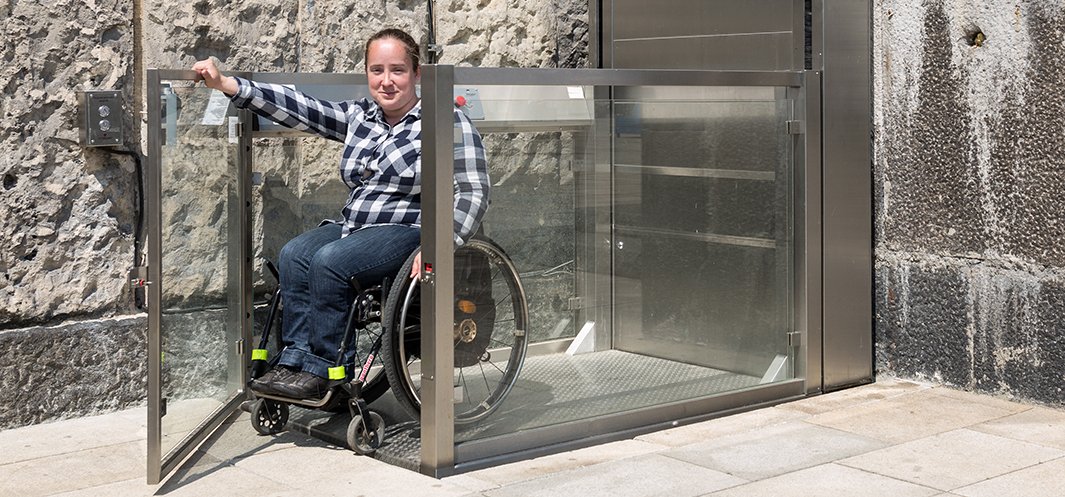Facilities for the disabled
ACCESSIBILITY OF THE MUSEUM BRANCHES
Main Building
The provision of special exterior and interior lifts, wheelchair lifts and portable rails made the Museum Main Building almost fully accessible to the disabled (no access to the cloakroom). The building has special restrooms for the mobility impaired. It is also equipped with a defibrillator.
The Bishop Erazm Ciołek Palace
There is a lift, the entrance has no doorstep, there is a restroom for the disabled located next to the lift. The building has an additional stair climber, platforms and portable rails necessary to climb the few stairs to adjoining rooms. It is also equipped with a defibrillator.
The Gallery of the 19th Century Polish Art
The lift is equipped with Braille buttons and voice control. No doorsteps or barriers. Additional cloakroom for the mobility impaired equipped e.g. with luggage lockers.
The restroom is fully adapted to the needs of people with different disabilities. Handles and buttons are easy to use even for those suffering from hand spasticity. The stairs to the restroom are equipped with aluminium ramps so that it is fully accessible.
Deficiencies: no extra amenities, cloakroom for the disabled is too small and poorly marked, special presentations (e.g. raised print) for the blind should be considered.
The Jan Matejko House
The branch is inaccessible to the mobility impaired, the special offer for the blind should be expanded.
The Józef Mehoffer House
The yard with a ramp to the garden, access to the café (the building is inaccessible, restrooms need to be adapted). Sightseeing with a sign language interpreter available.
The Feliks Jasieński Szołayski House
Ramps from the sidewalk to the hall and inside the hall. The annex has an exterior lift and a restroom for the mobility impaired. It is also equipped with a defibrillator. Sightseeing with a sign language interpreter available. A second entrance for the disabled should be considered, but it requires the entrance stairs to be converted.
The Karol Szymanowski Museum in the Villa “Atma” in Zakopane
Accessible restroom, ramps, wide doors.
No extra amenities.
Gallery of Antiquities – Princes Czartoryski Museum
The branch is inaccessible to wheelchairs. No amenities. Sightseeing with a sign language interpreter available. Some sculptures can be touched by the blind.
The Princes Czartoryski Library
The branch is inaccessible to wheelchairs. No amenities.
Emeryk Hutten-Czapski Museum
Lift, accessible restrooms, ramps, wide doors, walkways, stair climber, aluminium rails at the entrance stairs – however, the branch is hardly accessible to wheelchairs – necessary consultations, installation of a doorbell for the disabled, purchase of rails, staff training.
European Culture Centre EUROPEUM
Lift, restrooms, entrance ramp, wide doors, walkways, glass door safeguards, induction loop in educational rooms, extra amenities, raised printing system, atlas of the world with raised relief maps and Braille commentary, magnifying sheets for the visually impaired.
Main Building
The provision of special exterior and interior lifts, wheelchair lifts and portable rails made the Museum Main Building almost fully accessible to the disabled (no access to the cloakroom). The building has special restrooms for the mobility impaired. It is also equipped with a defibrillator.
The Bishop Erazm Ciołek Palace
There is a lift, the entrance has no doorstep, there is a restroom for the disabled located next to the lift. The building has an additional stair climber, platforms and portable rails necessary to climb the few stairs to adjoining rooms. It is also equipped with a defibrillator.
The Gallery of the 19th Century Polish Art
The lift is equipped with Braille buttons and voice control. No doorsteps or barriers. Additional cloakroom for the mobility impaired equipped e.g. with luggage lockers.
The restroom is fully adapted to the needs of people with different disabilities. Handles and buttons are easy to use even for those suffering from hand spasticity. The stairs to the restroom are equipped with aluminium ramps so that it is fully accessible.
Deficiencies: no extra amenities, cloakroom for the disabled is too small and poorly marked, special presentations (e.g. raised print) for the blind should be considered.
The Jan Matejko House
The branch is inaccessible to the mobility impaired, the special offer for the blind should be expanded.
The Józef Mehoffer House
The yard with a ramp to the garden, access to the café (the building is inaccessible, restrooms need to be adapted). Sightseeing with a sign language interpreter available.
The Feliks Jasieński Szołayski House
Ramps from the sidewalk to the hall and inside the hall. The annex has an exterior lift and a restroom for the mobility impaired. It is also equipped with a defibrillator. Sightseeing with a sign language interpreter available. A second entrance for the disabled should be considered, but it requires the entrance stairs to be converted.
The Karol Szymanowski Museum in the Villa “Atma” in Zakopane
Accessible restroom, ramps, wide doors.
No extra amenities.
Gallery of Antiquities – Princes Czartoryski Museum
The branch is inaccessible to wheelchairs. No amenities. Sightseeing with a sign language interpreter available. Some sculptures can be touched by the blind.
The Princes Czartoryski Library
The branch is inaccessible to wheelchairs. No amenities.
Emeryk Hutten-Czapski Museum
Lift, accessible restrooms, ramps, wide doors, walkways, stair climber, aluminium rails at the entrance stairs – however, the branch is hardly accessible to wheelchairs – necessary consultations, installation of a doorbell for the disabled, purchase of rails, staff training.
European Culture Centre EUROPEUM
Lift, restrooms, entrance ramp, wide doors, walkways, glass door safeguards, induction loop in educational rooms, extra amenities, raised printing system, atlas of the world with raised relief maps and Braille commentary, magnifying sheets for the visually impaired.
